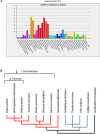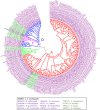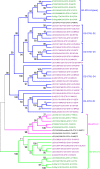Glycosyltransferase Family 61 in Liliopsida (Monocot): The Story of a Gene Family Expansion
- PMID: 30619412
- PMCID: PMC6297846
- DOI: 10.3389/fpls.2018.01843
Glycosyltransferase Family 61 in Liliopsida (Monocot): The Story of a Gene Family Expansion
Abstract
Plant cell walls play a fundamental role in several plant traits and also influence crop use as livestock nutrition or biofuel production. The Glycosyltransferase family 61 (GT61) is involved in the synthesis of cell wall xylans. In grasses (Poaceae), a copy number expansion was reported for the GT61 family, and raised the question of the evolutionary history of this gene family in a broader taxonomic context. A phylogenetic study was performed on GT61 members from 13 species representing the major angiosperm clades, in order to classify the genes, reconstruct the evolutionary history of this gene family and study its expansion in monocots. Four orthogroups (OG) were identified in angiosperms with two of them displaying a copy number expansion in monocots. These copy number expansions resulted from both tandem and segmental duplications during the genome evolution of monocot lineages. Positive selection footprints were detected on the ancestral branch leading to one of the orthogroups suggesting that the gene number expansion was accompanied by functional diversification, at least partially. We propose an OG-based classification framework for the GT61 genes at different taxonomic levels of the angiosperm useful for any further functional or translational biology study.
Keywords: Liliopsida; gene family expansion; glycosyltransferase family 61; orthologous genes; phylogeny; positive selection footprints.
Figures






Similar articles
-
Evolutionary Analyses of GRAS Transcription Factors in Angiosperms.Front Plant Sci. 2017 Mar 2;8:273. doi: 10.3389/fpls.2017.00273. eCollection 2017. Front Plant Sci. 2017. PMID: 28303145 Free PMC article.
-
Evolutionary divergence of β-expansin structure and function in grasses parallels emergence of distinctive primary cell wall traits.Plant J. 2015 Jan;81(1):108-20. doi: 10.1111/tpj.12715. Epub 2014 Nov 27. Plant J. 2015. PMID: 25353668
-
Species-specific size expansion and molecular evolution of the oleosins in angiosperms.Gene. 2012 Nov 10;509(2):247-57. doi: 10.1016/j.gene.2012.08.014. Epub 2012 Aug 24. Gene. 2012. PMID: 22951805
-
Genome histories clarify evolution of the expansin superfamily: new insights from the poplar genome and pine ESTs.J Plant Res. 2006 Jan;119(1):11-21. doi: 10.1007/s10265-005-0253-z. Epub 2006 Jan 13. J Plant Res. 2006. PMID: 16411016 Review.
-
Global grass (Poaceae) success underpinned by traits facilitating colonization, persistence and habitat transformation.Biol Rev Camb Philos Soc. 2018 May;93(2):1125-1144. doi: 10.1111/brv.12388. Epub 2017 Dec 12. Biol Rev Camb Philos Soc. 2018. PMID: 29230921 Review.
Cited by
-
A thousand metagenome-assembled genomes of Akkermansia reveal phylogroups and geographical and functional variations in the human gut.Front Cell Infect Microbiol. 2022 Aug 2;12:957439. doi: 10.3389/fcimb.2022.957439. eCollection 2022. Front Cell Infect Microbiol. 2022. PMID: 35982777 Free PMC article.
-
Genome assembly of Musa beccarii shows extensive chromosomal rearrangements and genome expansion during evolution of Musaceae genomes.Gigascience. 2022 Dec 28;12:giad005. doi: 10.1093/gigascience/giad005. Epub 2023 Feb 21. Gigascience. 2022. PMID: 36807539 Free PMC article.
-
Genome-Wide Classification and Phylogenetic Analyses of the GDSL-Type Esterase/Lipase (GELP) Family in Flowering Plants.Int J Mol Sci. 2022 Oct 11;23(20):12114. doi: 10.3390/ijms232012114. Int J Mol Sci. 2022. PMID: 36292971 Free PMC article. Review.
-
Highly differentiated genomic properties underpin the different cell walls of Poaceae and eudicots.Plant Physiol. 2023 Dec 30;194(1):274-295. doi: 10.1093/plphys/kiad267. Plant Physiol. 2023. PMID: 37141316 Free PMC article.
-
The biosynthesis, degradation, and function of cell wall β-xylosylated xyloglucan mirrors that of arabinoxyloglucan.New Phytol. 2023 Dec;240(6):2353-2371. doi: 10.1111/nph.19305. Epub 2023 Oct 12. New Phytol. 2023. PMID: 37823344 Free PMC article.
References
LinkOut - more resources
Full Text Sources
Miscellaneous

